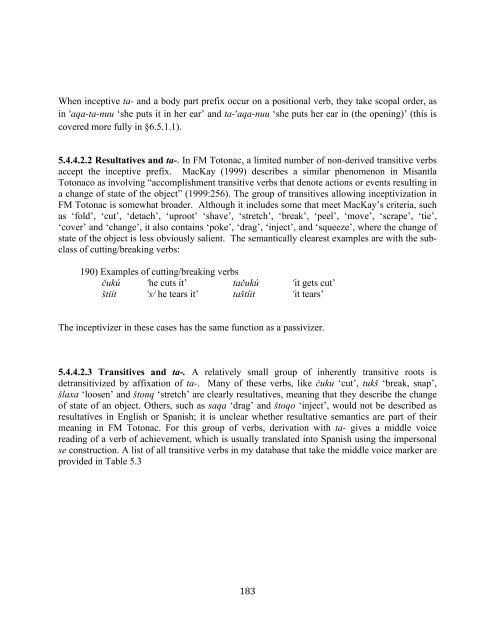The phonology and morphology of Filomeno Mata Totonac
The phonology and morphology of Filomeno Mata Totonac
The phonology and morphology of Filomeno Mata Totonac
Create successful ePaper yourself
Turn your PDF publications into a flip-book with our unique Google optimized e-Paper software.
When inceptive ta- <strong>and</strong> a body part prefix occur on a positional verb, they take scopal order, as<br />
in ’aqa-ta-nuu ‘she puts it in her ear’ <strong>and</strong> ta-’aqa-nuu ‘she puts her ear in (the opening)’ (this is<br />
covered more fully in §6.5.1.1).<br />
5.4.4.2.2 Resultatives <strong>and</strong> ta-. In FM <strong>Totonac</strong>, a limited number <strong>of</strong> non-derived transitive verbs<br />
accept the inceptive prefix. MacKay (1999) describes a similar phenomenon in Misantla<br />
<strong>Totonac</strong>o as involving “accomplishment transitive verbs that denote actions or events resulting in<br />
a change <strong>of</strong> state <strong>of</strong> the object” (1999:256). <strong>The</strong> group <strong>of</strong> transitives allowing inceptivization in<br />
FM <strong>Totonac</strong> is somewhat broader. Although it includes some that meet MacKay’s criteria, such<br />
as ‘fold’, ‘cut’, ‘detach’, ‘uproot’ ‘shave’, ‘stretch’, ‘break’, ‘peel’, ‘move’, ‘scrape’, ‘tie’,<br />
‘cover’ <strong>and</strong> ‘change’, it also contains ‘poke’, ‘drag’, ‘inject’, <strong>and</strong> ‘squeeze’, where the change <strong>of</strong><br />
state <strong>of</strong> the object is less obviously salient. <strong>The</strong> semantically clearest examples are with the subclass<br />
<strong>of</strong> cutting/breaking verbs:<br />
190) Examples <strong>of</strong> cutting/breaking verbs<br />
$ukú ‘he cuts it’ ta$ukú ‘it gets cut’<br />
#tiit ‘s/ he tears it’ ta#tíit ‘it tears’<br />
<strong>The</strong> inceptivizer in these cases has the same function as a passivizer.<br />
5.4.4.2.3 Transitives <strong>and</strong> ta-. A relatively small group <strong>of</strong> inherently transitive roots is<br />
detransitivized by affixation <strong>of</strong> ta-. Many <strong>of</strong> these verbs, like $uku ‘cut’, tuk# ‘break, snap’,<br />
#laxa ‘loosen’ <strong>and</strong> #tonq ‘stretch’ are clearly resultatives, meaning that they describe the change<br />
<strong>of</strong> state <strong>of</strong> an object. Others, such as saqa ‘drag’ <strong>and</strong> #toqo ‘inject’, would not be described as<br />
resultatives in English or Spanish; it is unclear whether resultative semantics are part <strong>of</strong> their<br />
meaning in FM <strong>Totonac</strong>. For this group <strong>of</strong> verbs, derivation with ta- gives a middle voice<br />
reading <strong>of</strong> a verb <strong>of</strong> achievement, which is usually translated into Spanish using the impersonal<br />
se construction. A list <strong>of</strong> all transitive verbs in my database that take the middle voice marker are<br />
provided in Table 5.3<br />
! ",'!

















